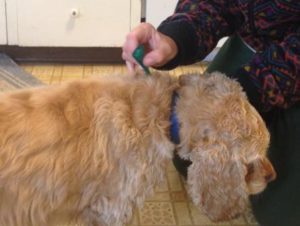- What do you use for a flea and tick preventative?
- Do you use the same product year after year since it works?
- Did someone recommend the product?
- With new stories about flea and tick preventives available, are you rethinking your usual strategy? I know I am.
For many years, I was against using flea and tick pesticides on my dog. I took her hiking and camping with me through the north woods of Wisconsin down to the Smokey Mountains. She often had many ticks, which I pulled off her.
One night while camping in the Sandhills of Nebraska next to the Niobrara River, my springer spaniel, Kaylee, must have lain in a tick nest before entering my tent. All night I kept feeling ticks crawling on me. I pulled off at least half a dozen that night as I tried to sleep between her and my husband, who, of course, didn’t feel any ticks. I hate that feeling—of a tick crawling on me in the middle of the night. Then I’d continue to feel as if ticks were crawling on me for hours.
Still, I wouldn’t use pesticides on Kaylee. I’d comb her and thoroughly search any tiny bumps every day from March through November. She didn’t mind my extra attention with extra pets and rubs, but barely tolerated combing her thick fur and pulling ticks out of her skin.
Fleas were a problem in the late summer and I religiously used a fine-toothed flea comb every day, drowning the ones I found in a dish filled with soapy water. Occasionally Kaylee had too many fleas and I had to give her a flea soap bath. She hated waiting the ten minutes required to kill the fleas as she stood with soapy fur in the cold basement laundry tub. The flea soap was mild and only killed the fleas on the dog at the time, so a few days later she could need another bath. When we lived in a log cabin style house, the fleas found crevices to live in and stayed around all winter, even with me vacuuming the rugs almost daily. Looking back, I’m amazed at how much time and effort I put into flea and tick patrol.
My aversion to pesticides ran deep. Back in the mid-1980s, my parent’s dog was given an insecticide dip by the vet. According to my mom, Skippy deteriorated within days of the dip, becoming disoriented and shaking uncontrollably. Notably, he was an old dog, around twelve, but he was my best friend during my teenage years. They had to euthanize him because of his suffering. My fear of poisoning Kaylee was why I refused to use pesticides. I knew there was a risk of catching a disease from the ticks—but I thought it was minimal.
But in October of 2003, my next springer, Cassie, developed paralysis in all four legs within the course of about twelve hours. The vet said one possibility was a tick-borne disease, like Lyme disease. About six weeks before, Cassie had hundreds of tiny deer ticks bites and I had used a spot-on treatment given to me by her agility trainer. The ticks fell off and I had forgotten about it until her paralysis. Cassie had been vaccinated for Lyme disease, so her blood tests showed her having antibodies. But Lyme disease symptoms include generalized muscle weakness that progresses at a slower rate.
A neurologist diagnosed Cassie with Coon Hound Paralysis, an autoimmune disease that leaves the dog temporarily paralyzed. It’s very similar to Guillain-Barré Syndrome in people. After five days of observation at the emergency veterinary hospital and thousands of dollars, Cassie made a full recovery.
My vet told me to use a spot-on treatment for ticks since they can cause so many diseases. So I did, for many years. I never thought about changing my routine since the vet had recommended it, even the brand I should use. Cassie loved walks in the woods, so I always used the pesticides, but she passed away two years ago. Now I have inherited my mom’s two older cocker spaniels, which are homebodies. I mostly walk them around our neighborhood where the lawns and shrubs are well kept—not prime tick habitat.

I’ve been noticing articles discussing alternative methods for flea and tick control, so during our annual visit last month, I asked my vet what she thought. She said that if the cockers stay in areas with manicured lawns, then they probably don’t need tick preventives during the spring and fall, but I should use a flea preventative during the late summer.
What is your dog’s exposure to areas that have ticks and fleas?
Ticks are most active in spring and fall, although in the Chicago area, I’ve seen them as early as the middle of February and as late as November. They are more common from April through early June, but I’ve also seen them throughout the summer months. They usually occur in tall grasses and forested areas. I’m outside a lot for my job and sometimes I’ve had ticks on me from walking only a few feet off a gravel trail for a minute in the forest preserve, but have not found them when walking in dense woods on islands. So ticks can occur almost anywhere—it’s hard to predict.
If your dog stays in the city or suburbs around manicured lawns, its risk for exposure to ticks is minimal. But you should still check for them, usually by giving them a thorough petting once a day—that they love!
Fleas flourish in grasses—even mowed lawns. I’ve found that some houses and yards have more fleas than others depending on if dogs with fleas had lived there and built up a population, and if there is good habitat. When I moved away from the log cabin house where fleas survived inside, to my current house, the fleas disappeared on my dog—even though it was during prime flea season in the middle of summer.
What are spot-on treatments?
Spot-on treatments are pesticides that are absorbed through the skin. But these chemical have also been found in their organs and fat. Several chemicals used for spot-on treatments include:
- Fipronil—is the chemical recommended by my vet, and I have used for years in my Frontline Plus treatments. It works well, but according to Animal Wellness (Vol. 19, Issue 2); fipronil can cause nervous system and thyroid toxicity, cancer, and other conditions, as well as hair loss at the application point.
- Imidacloprid—is in the chemical class of neonicotinoids and is a neurotoxin. This chemical can cause thyroid, liver, kidney, heart and other organ problems. Imidacloprid is a common chemical used in flea and tick pesticides and may be used in combinations with other chemicals.
- Pyrethrins, pyrethroids, and permethrins—are often thought of as safer chemicals since pyrethrins come from chrysanthemum plants. Pyrethroids and permethrins are synthetic alternatives. But actually, these chemicals have a higher toxicity than the others mentioned and have caused some fatalities.
What are the alternatives to spot-on treatments?
Alternatives to spot-on treatments are becoming more available and I recommend researching these products more thoroughly.
- Oral chews are now available for monthly or longer treatments, such as Bravecto—that claims to last up to 12 weeks for most ticks. This product requires a prescription from your veterinarian.
- Topical sprays and squeeze on’s may be better if your dog only occasionally visits tick-infested areas, like my cocker spaniels. Petzlife has a topical spray that lasts several weeks as does Ruff on Bugs, Wondercide, and Only Natural Pet. I’m sure there are many others. They all use different chemicals, so you should do some research.
- Powders added to your dog’s food. These may take a week or so to be effective.
- A tag placed on your dog’s collar. It uses your pet’s bio-energy to create a natural preventative to biting insects. It takes about three weeks to become effective and lasts about a year. Only Natural Pet produces this product.
What do I recommend?
As you can see, there are many alternatives out there and I highly recommend researching them. Your vet may only recommend products that they sell, are easy to use, and have a long history. So keep an open mind and think about trying some of these alternatives. I certainly will—once my Frontline Plus supply is used up.
Please leave a comment on your experiences with flea and tick preventives or leave me a note on my contact page or sign up to receive future blog posts.
https://animalwellnessmagazine.com/ Spot-on Flea and Tick Preventives, Volume 19, Issue 2
http://www.peteducation.com/article.cfm?c=2+2111&aid=598 Dr. Foster and Smith article on pet education, Ingredients in Flea & Tick Control Products.


Hey, I like the idea of the tag that uses the body’s bio energy to create a natural preventative.. Why don’t they have those for humans?
Thanks for the good advice. We’ve been lucky not to have had any problems with those pests as long as we stay in the yard.
We use trefexis. I usually give Steeler 3/4 tablet and give 1/4 to Kelly’s small dog Otis. No side effects so far.